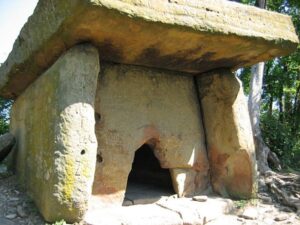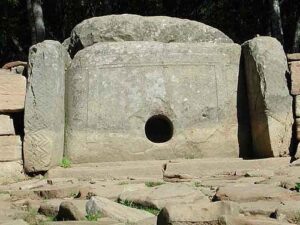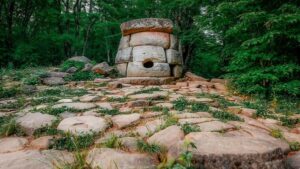On the western slopes of the Caucasus Mountains, ancient structures known as dolmens continue to intrigue archaeologists and locals alike. These megalithic tombs, constructed with immense stone slabs, date back to around 3,000 BC. Dubbed “the houses of the dead” by local inhabitants, these dolmens reveal the complexities of ancient civilizations, their beliefs, and their impressive architectural skills. Let’s delve deeper into what these enigmatic structures tell us.
1. What Are Dolmens?
Dolmens are ancient stone tombs made of massive stone blocks, some as large as a small house. They are typically constructed from sandstone or limestone—stones that, although relatively soft and easy to cut, require significant effort to shape and transport due to their weight and size. These dolmens served as communal or family tombs, where the deceased were placed with goods they may have valued in life.
These structures aren’t unique to the Caucasus; dolmens have been found across Europe, Asia, and the Middle East. However, the Caucasus dolmens are distinct in their craftsmanship and longevity, standing as some of the oldest and most intriguing megalithic sites.

2. The “Houses of the Dead”
The name “houses of the dead” speaks to the cultural and spiritual significance these structures had for the communities that built them. Built with large stone blocks, often transported from miles away, dolmens were meant to endure the test of time. They served as tombs, but they were also crafted as spaces for ritual, reflecting a deep belief in an afterlife or in honoring ancestors.
Each dolmen had a small entrance hole, often covered with a stone plug. This entrance is sometimes interpreted as a symbolic portal for the souls of the deceased, a recurring motif in ancient cultures that believed in a journey after death.
3. How Were These Massive Structures Built?
One of the most fascinating aspects of the Caucasus dolmens is the sheer scale of labor and skill involved in their construction. Stone slabs weighing several tons were carved using simple tools like stone hammers and bronze chisels. Remnants of these tools have been found near the sites, suggesting that much of the carving may have been done on-site. Transporting these massive slabs over rough terrain required ingenuity, and it’s speculated that log rollers or sledges may have been used, though no direct evidence of this exists.
Labor and Skill:
Constructing a dolmen would have been a community effort, possibly requiring dozens of workers and significant resources. The dolmens’ construction demonstrates that these ancient people possessed both the organization and the technical knowledge needed to handle such ambitious projects.

4. Looting and Later Uses
Many of the dolmens contained treasures such as jewelry, pottery, and other goods intended to accompany the dead. However, over the centuries, most of these treasures have been looted. During World War II, some dolmens were even repurposed as detonation chambers for the safe disposal of old bombs, damaging or partially destroying them.
5. Dolmens as Astronomical Monuments
The positioning of many dolmens on hilltops, flat plateaus, or sunny slopes isn’t accidental. Archaeologists have noted that many of these tombs are aligned with significant celestial events, such as the solstices or equinoxes. This alignment suggests that the dolmens may have also been used for ceremonial or religious purposes connected to astronomy.
Ancient Knowledge of Astronomy:
For an ancient society to have aligned their tombs with celestial events implies a sophisticated understanding of the natural world. It points to a society that tracked the seasons and relied on the movement of the sun and stars for rituals or agricultural cycles.

6. Community and Ritual Use
Aside from serving as burial chambers, some dolmens were designed with enough space to accommodate gatherings. Stone altars have been found in some dolmens, and the ample interiors suggest that they may have been used for community rituals, religious ceremonies, or ancestor worship. In some cases, engravings and carvings on the stone slabs have been found, hinting at rituals or beliefs that honored ancestors and revered the cycle of life and death.
7. Preserving Prehistoric Culture
Today, these “houses of the dead” are invaluable relics of an ancient culture. The stone engravings found on some dolmens offer a unique glimpse into the prehistoric world, providing clues to the rituals, spiritual beliefs, and customs of the ancient people who built them. The preservation of these sites is crucial, as they are not only archaeological treasures but also cultural touchstones that help connect present-day communities with their ancient heritage.

8. The Enduring Mystery of the Caucasus Dolmens
Despite extensive research, many questions remain about the people who built these dolmens, their motivations, and the full extent of their practices. The Caucasus dolmens stand as silent witnesses to an ancient world, offering hints but rarely giving clear answers about the lives and beliefs of the people who built them. Their scale, architectural precision, and celestial alignments suggest a deep knowledge and a respect for nature and the afterlife, values that still resonate today.
In sum, the Caucasus dolmens are much more than ancient burial sites. They are testaments to human ingenuity, resilience, and the eternal desire to understand and honor the mysteries of life and death. As we continue to study these “houses of the dead,” we uncover not just the secrets of the structures themselves, but also insights into the early human journey—a journey that sought meaning in both the stars above and the earth below.
